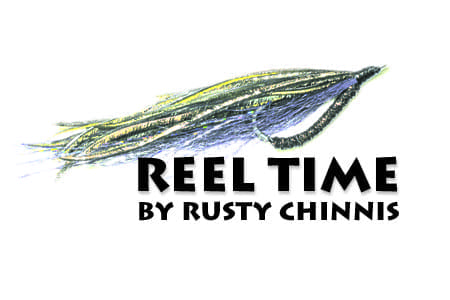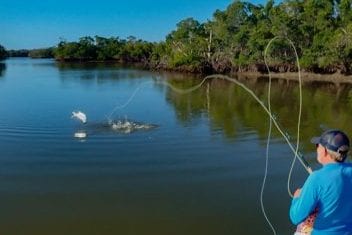It was one of those mornings where time almost stands still, where we wish it would. A light, cool, late spring breeze ruffled the water’s surface as it swirled and eddied around mangrove islands festooned with oyster and barnacle-studded roots.
The morning light was deep and golden and the reflections on the water’s surface enhanced the magic as it moved inexorably towards the Gulf. Moments later, the reverie was broken as a tarpon rolled on the surface along one of the mangrove edges. Putting down the camera, I picked up my fly rod and made a cast to the bubbles that signaled the movements of the submerged tarpon. Counting to 10, I let the fly sink before beginning a staccato retrieve intent on keeping the fly deep in the water column.
On my third strip, the fly suddenly stopped and I set the hook with a coordinated movement of line and rod hands. Moments later a 40-pound tarpon erupted on the water’s surface in an aerial display that was accentuated by the serene surroundings. In a characteristic fight, the fish spent the next few minutes more in the air than the water before spitting the hook in a spectacular scaled rattling leap. It was “a Palm Beach release,” a perfect scenario made even better when a fat, 20-plus-inch trout inhaled the fly as I was retrieving it back to the boat. Two fish on one cast – not a bad way to begin a day deep in Florida’s Ten Thousand Islands.
It had been a challenging early spring as every trip I had planned was interrupted by fronts coursing from the north. Fortunately, my guide, Captain John Hand of Redfish Landing Guide Service in nearby Everglades City, was able to reschedule me. I spent two days with Hand exploring an amazing diversity of habitats. On the first day, after the two fish in one cast episode, Hand took me to a basin deep in the mangroves where I had multiple shots at laid up tarpon, some well over 100 pounds. This is one of the most demanding and sought-after scenarios in fly fishing, one that requires a pinpoint cast to a target that is sometimes only seen as a ghost-like apparition. The cast is even more challenging as the angler has to determine which end of the fish is which, often not apparent in the off-color water.
While I wasn’t able to connect on a number of opportunities, just the experience of casting to triple digit fish in an area that resembled a farm pond was rewarding. In just over two hours we saw and cast to a dozen tarpon, several cruising sharks and a tripletail.
On the second day, the wind was up at the approach of yet another front so we elected to fish north amid the protection of the mangrove islands. Although the tarpon proved elusive we connected with a number of snook on eight-weight outfits along the mangrove-ringed islands. Towards the end of the day I did manage to have an almost perfect presentation to a large laid up tarpon. Unfortunately, I made my cast to the wrong end of the fish and watched as the tarpon spooked and swam away. We were scheduled to fish the next day but the forecast of 20-25 mph winds with the approaching front caused us, wisely, to reconsider.
Captain John Hand fishes the saltwater from Marco Island south to the Everglades and has his Hell’s Bay Guide customized with an innovative leaning post that is both comfortable and stabilizing for his anglers. He targets mainly redfish, snook, tarpon and trout but also takes advantage of the myriad variety of other species that swim these rich coastal waters. Anglers looking for a different experience can explore the freshwater canals that crisscross the Everglades with Hand. He has explored these areas and divined the habits of a broad range of species, from baby tarpon to black and peacock bass.
If you haven’t explored this part of Florida, you couldn’t find a better guide than Hand to introduce you. He can be reached by calling 239-842-7778.
































